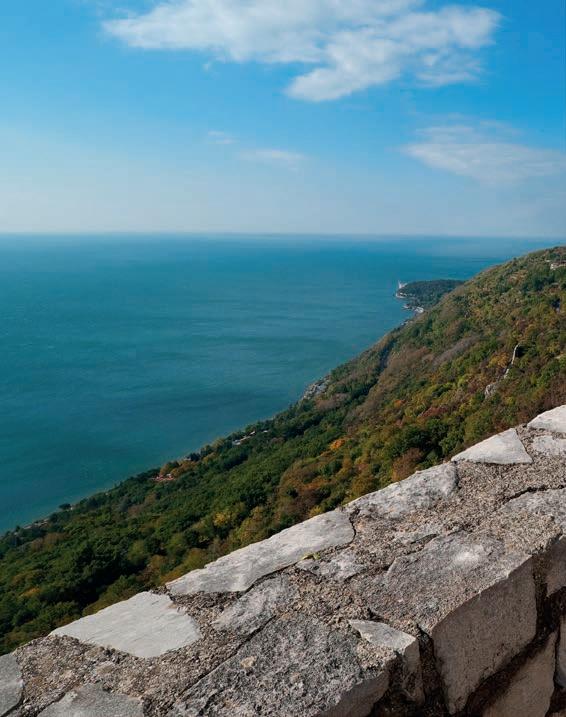
8 minute read
Pedalare senza confini
PEDALARE SENZA CONFINI di /by Fabrizio Masi — Cycling without borders
Il nostro territorio e la città di Trieste, ha rappresentato da sempre il limes, la terra di frontiera, porta d’ingresso e di connessione tra la penisola italiana e i Balcani, tra il mondo mediterraneo e quello dell’Europa centrale. È stato ed è punto d’incontro per culture, tradizioni e lingue diverse: qui si sono mescolate in modo originale la civiltà latina, slava e germanica, che hanno lasciato preziose testimonianze, prima di essere travolte delle distruttive spinte nazionalistiche del Novecento.
Advertisement
In una nuova Europa, questo territorio assume un ruolo ancora più strategico anche per la sua funzione di cerniera e passaggio tra una regione e l’altra. Dal punto di vista cicloturistico, la provincia si colloca lungo assi di collegamento importanti ospitando alcuni itinerari internazionali. I percorsi della rete ciclistica europea Eurovelo 8 (percorso Mediterraneo da Tarifa ad Atene) e Eurovelo 9 (dal Baltico all’Adriatico: Danzica-Pola).
La città di Trieste è inoltre il capolinea della ciclovia dell’AIDA (Alta Italia Da Attraversare) che parte dal passo del Moncenisio attraversando 4 regioni italiane, e base di partenza per la via della Parenzana che connette Muggia a Parenzo in Croazia, attraverso la Slovenia e parte dell’Istria.
TRIESTE LIFESTYLE
64
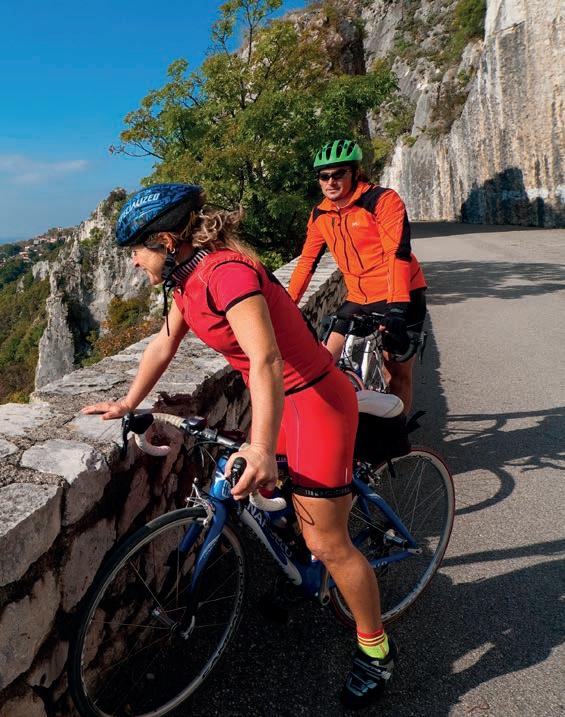
The city of Trieste and its surroundings have always been the symbol of limes, the frontier, access point to and connecting line between the rest of the Italian peninsula and the Balkans, the Mediterranean sea and Central Europe. A crossroad of cultures, traditions, and idioms this is where Latin, Slavic, and Germanic civilisations met and mixed, thriving in their unique melting pot before being swept away by the nationalistic drives of the 20th century.
In the new Europe, this territory has acquired an even greater strategic role as connecting hub and passage way between regions. In terms of cycling tourism, the province of Trieste is crossed by various international connecting routes, such as two lines of the European network of long-distance cycling routes: EuroVelo 8 (the Mediterranean route from Cádiz in Spain to Athens in Greece) and EuroVelo 9 (the Amber route, from Poland to Croatia, from the Baltic to the Adriatic sea).
The city of Trieste is also the terminus of AIDA (Alta Italia Da Attraversare) cycle route, a cycling tour starting from the Mont Cenis pass and moving eastward across a Italian regions. AIDA’s terminus is also the starting point of the Via della Parenzana, connecting Muggia to Poreč (Croatia), passing through Slovenia and part of the Istrian Peninsula.
Un'escursione nella natura sull'altopiano carsico a cavallo della frontiera tra Slovenia e Italia. Da Trieste a Postumia salendo sul treno (porta le biciclette) che viaggia verso Lubiana. Prima di iniziare a pedalare potremmo scoprire le famose grotte sotterranee, scavate nelle profondità delle colline. Da qui, raggiungere l'impenetrabile castello di Predjama, incuneato in uno stretto crepaccio sulla parete a strapiombo. L'escursione si svolge lungo verdi colline tra frequenti saliscendi su strade minori fino a raggiungere il borgo di Štanjel, che domina il Carso regalando un'impagabile vista. Passaggio alle scuderie di Lipica che ospitano i bellissimi cavalli bianchi, legati alla scuola di equitazione di Vienna. Da Sežana, seguendo il sentiero Ressel, valicheremo il confine con l'Italia a Basovizza per scendere verso il centro di Trieste lungo la ciclopedonale G. Cottur. Attraverseremo la Riserva naturale della Val Rosandra, sul tracciato della ferrovia che collegava Trieste a Erpelle regalandoci scorci unici in un ambiente di grande pregio naturalistico.
Difficoltà: *** (suggerita E-bike) 95 Km + 1080 mt dislivello.
A cycling tour surrounded by nature on a stretch of the Karst Plateau across the border from Slovenia and Italy. The first leg of this tour is a train ride from Trieste to Postojna on the connecting line to Ljubljana. At Postojna, you may want to stop for a visit at the local cave park, a set of underground cave settlements dating back to the Palaeolithic era. The cycling route starts here, on the way to the fortified castle of Predjama, wedged within a crevice on the cliff edge. This leg runs through green hills, frequently climbing and descending on secondary roads, until it reaches the hamlet of Štanjel and its spectacular view dominating the hills. The nearby Lipica Stud Farm is the origin of the famous Lipizzan white horse, the very breed trained at Vienna’s Spanish Riding School. From Sežana, proceed on Sentiero Ressel to Basovizza, where you will once again cross the border to Italy and Trieste. Follow the pedestrian/cycle route Ciclopedonale G. Cottur leading into Val Rosandra Natural Reserve alongside the old railway tracks that used to connect Trieste to Erpelle and enjoy the various glimpses of the unique nature surrounding the path.
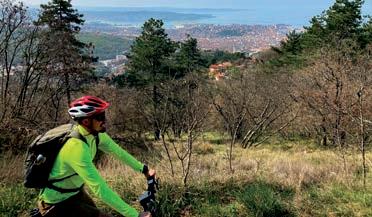
Difficulty level: *** (E-bike recommended) 95 Km + 1,080 mt elevation gain
La Parenzana in bicicletta
Da Trieste a Parenzo lungo la ex linea ferroviaria
Istria in bicicletta
Da Trieste a Pola lungo la costa occidentale
Ciclovia AIDA – est Da Verona a Trieste
Istria. Storie oltre i confini
Tra memorie, radici e libertà Un itinerario che segue il tracciato dell’AIDA (Alta Italia Da Attraversare) e connette un paesaggio modellato da colline tappezzate a vigneti, alla costa del ciglione carsico e alla città di Trieste. Da Cormons, verso sud, scopriremo la città fortificata di Gradisca, superando la Bisiacarìa e il sacrario di Redipuglia, imponente cimitero che ospita le spoglie dei soldati italiani caduti nel primo conflitto mondiale sul Carso. Superata Monfalcone, troveremo le Bocche del Timavo, il fiume sotterraneo che “risorge” dopo aver percorso 40 km nelle profondità del Carso. La costiera ci sorprenderà con il panorama spettacolare che si apre sul golfo. Una strada aperta che ci porterà a raggiungere il castello di Miramare, alle porte della città. Arrivati in centro, attraversando il Porto Vecchio, troveremo la Piazza dell’Unità d’Italia, con i suoi palazzi asburgici che guardano al mare.Il percorso corre su strade minori e ciclabili nella prima parte, sulla strada statale costiera nella seconda. Non adatto ai bambini.
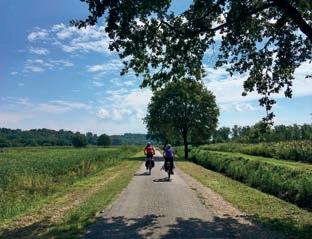
Difficoltà: ** 55 Km + 150 mt dislivello.
This itinerary follows the local stretch of the AIDA (Alta Italia Da Attraversare) cycle route, running from the vinecovered hills of the inland all the way to the Karst shoulder and the city of Trieste. Moving southward from Cormons, after the Bisiacaria and Redipuglia War Memorial (the largest war memorial in Italy, housing the remains of Italian soldiers killed between 1915 and 1917 in the eleven battles fought on the Karst and Isonzo front), this itinerary leads into the old citadel of Gradisca. After Monfalcone, visitors will reach the Bocche del Timavo (lit. the mouths of the Timavo river), a 40-km underground watercourse, fed mainly by the Karst sinking rivers, that eventually emerges in this area. As the road approaches the coast, visitors will be amazed by the spectacular view overlooking the gulf. This open road passes right next to the Castle of Miramare before entering Trieste. The city stretch continues along the seafront, passing Porto Vecchio and Piazza dell’Unità d’Italia, with its imposing Hapsburg facades overlooking the sea. This itinerary runs on both secondary roads and cycle lanes (first part), and the coast-line state road (second part). Not suitable for children.


3 La Parenzana e l’Istria
Un percorso che oggi, unisce tre nazioni – Italia, Slovenia e Croazia – attraversando l’Istria nord-occidentale. Da Muggia a Parenzo passando per Capodistria, Portorose, Buie, Grisignana, Montona e Visinada, lungo quella che tra il 1902 e il 1935 è stata una popolare linea ferroviaria a scartamento ridotto. Chiamata anche “Strada della Salute e dell’amicizia”, la Parenzana corre su ciclabile asfaltata in Italia e Slovenia, su sterrato nella parte croata. Si può affrontare in giù giorni oppure “assaggiarne” il tratto iniziale magari fino a Pirano (35 km), perla della costa slovena. L’itinerario, con pendenze accessibili, ci accompagnerà tra città costiere di impronta veneziana e antichi borghi medievali all’interno, in un continuo alternarsi di paesaggi e scenari naturali. Pedalare lungo questo tracciato significa ripercorrere la storia del territorio attraverso un secolo di cambiamenti ed evoluzioni storico-politiche che hanno disegnato nuovi scenari in queste terre. An itinerary connecting three neighbouring countries Italy, Slovenia, and Croatia and crossing the northwestern side of the Istrian peninsula. From Muggia to Poreč, passing through Koper, Portorož, Buje, Grožnjan, Motovun, and Vižinada, alongside the former narrowgauge railway, operating between 1902 and 1935. Also known as “the Route of Health and Friendship”, Parenzana runs partly on a paved cycle lane (Italy and Slovenia) and partly on gravel roads (Croatia). You can choose to cover the entire itinerary, planning a multi-day trip, or you may select only part of it, for instance the first stretch to Piran (35 km), a real jewel of Slovenia’s coast. This route runs across easy inclines through coastal cities with their Venetian architecture and inland medieval hamlets, spaced out by breathtaking natural landscapes. A bike ride through these territories is like a journey through time, during a century of historic and political changes that have shaped this land.
Difficulty level: *** (MTB recommended) 120 Km + 1,240 mt elevation gain.
Associazione di promozione sociale che offre esperienze e attività in movimento, prevalentemente in bicicletta, mirate alla scoperta del territorio, della sua cultura e iniziative di conoscenza ambientale per scuole ed adulti. Promuove esperienze autentiche, per valorizzare le differenze e le specificità dell’ambiente attraversato, nel pieno rispetto della comunità ospitante. –A social promotion association that offers experiences and activities on the move, mainly by bicycle, aimed at discovering the territory, its culture and environmental knowledge initiatives for schools and adults. It promotes authentic experiences, to enhance the differences and specificity of the environment, in full respect of the host community.
Info escursioni e noleggio bici
Bike point: Muggia, Porto San Rocco (strada per Lazzaretto 2) T. 339 4150897 / 370 3608319 www.viaggiareslow.it info@viaggiareslow.it
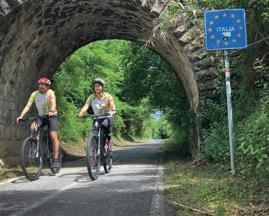



seguici sui social











